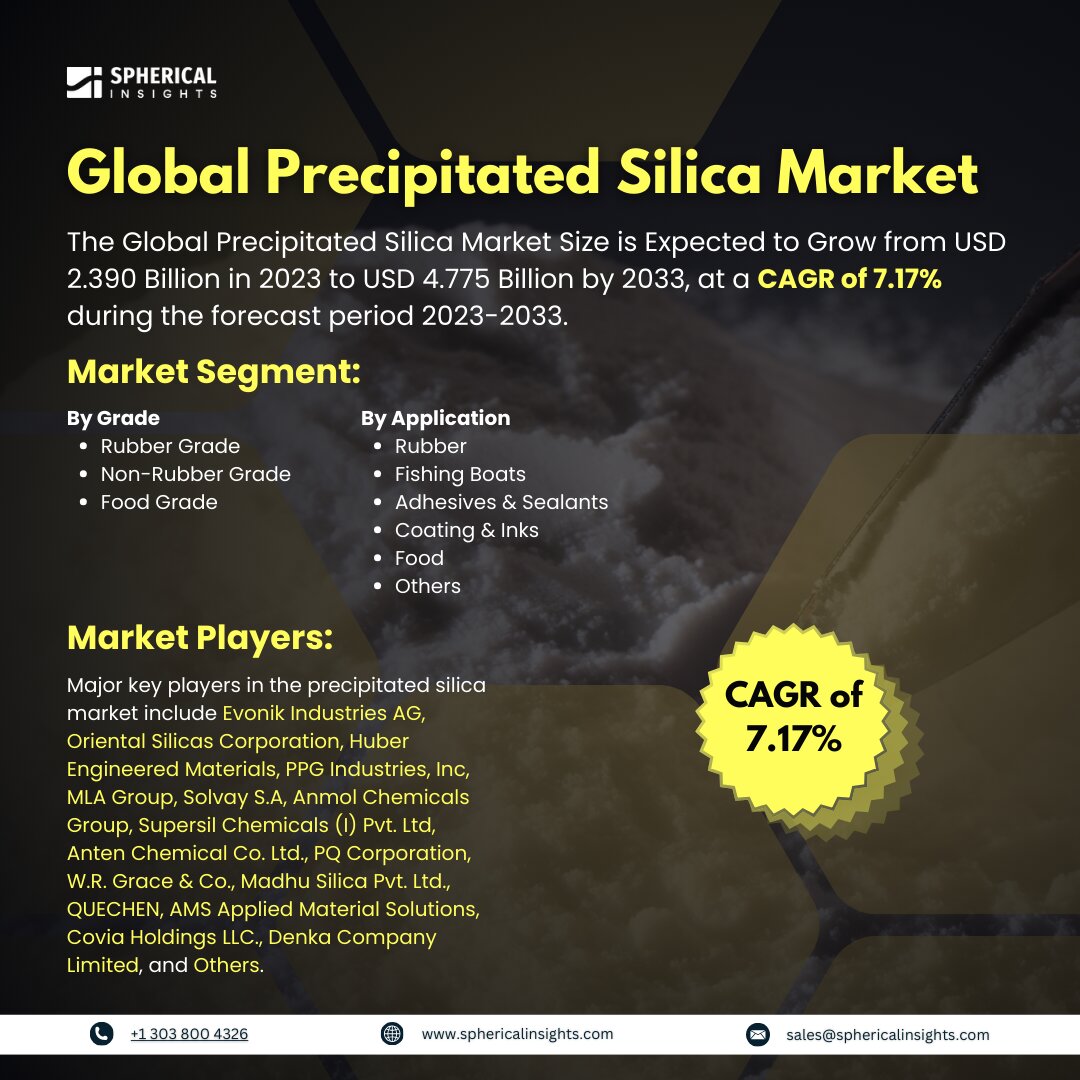Global Precipitated Silica Market Size to worth USD 4.775 Billion by 2033
According to a research report published by Spherical Insights & Consulting, the Global Precipitated Silica Market Size is Expected to Grow from USD 2.390 Billion in 2023 to USD 4.775 Billion by 2033, at a CAGR of 7.17% during the forecast period 2023-2033.
Browse key industry insights spread across 210 pages with 110 Market data tables and figures & charts from the report on the Global Precipitated Silica Market Size, Share, and COVID-19 Impact Analysis, By Grade (Rubber Grade, Non-Rubber Grade, and Food Grade), By Application (Rubber, Fishing Boats, Adhesives & Sealants, Coating & Inks, Food, and Others), By End-User (Personal Care & Cosmetics, Automotive, Agriculture, Electronics, and Others), and By Region (North America, Europe, Asia-Pacific, Latin America, Middle East, and Africa), Analysis and Forecast 2023 – 2033.
The precipitated silica market is the production and sale of synthetic amorphous silicon dioxide, valued for its inert, non-toxic properties. It is used in various industries like rubber, agrochemicals, oral care, food, paints, adhesives, sealants, and electronics. The market is expanding because of the increased need for sustainable materials, agrochemicals, and rubber, as well as the growing number of electric vehicles being produced. The extensive use of precipitated silica in industries like food, agriculture, rubber, and others is driving the market's growth. The reason behind this is the rise in demand from sectors such as food, agrochemicals, rubber, and others. The automotive industry heavily relies on precipitated silica, a key ingredient in tires, for its strength, durability, and fuel efficiency. As the industry grows globally, demand for high-quality tires is increasing. Precipitated silica extends tire tread life and reduces rolling resistance, helping automakers meet strict fuel economy and emission standards. With rising vehicle ownership and higher mileage driven, replacement tire demand remains robust, highlighting the importance of precipitated silica in the automotive industry. The global precipitated silica market is experiencing growth due to its increasing use in electronics, particularly as a reinforcing filler in silicone rubber. This material's excellent insulating and dielectric properties are crucial for component manufacturing in consumer electronics. Government initiatives such as the Central Salt & Marine Chemicals Research Institute (CSMCRI) in Gujarat, India, has created a method for making precipitated silica that is finely split. This project intends to improve precipitated silica's quality and manufacturing efficiency, making it more appropriate for a range of industrial uses. However, the global precipitated silica market faces challenges like fluctuating raw material prices and environmental regulations, impacting manufacturers' costs and profitability.
The rubber grade segment accounted for the highest share of 45.9% in 2023 and is expected to grow at a significant CAGR during the forecast period.
Based on the grade, the precipitated silica market is classified into rubber grade, non-rubber grade, and food grade. Among these, the rubber grade segment accounted for the highest share of 45.9% in 2023 and is expected to grow at a significant CAGR during the forecast period. The rubber industry is consuming over 60% of precipitated silica globally, primarily used as a reinforcing filler and thickening agent in tire production. Factors like rising vehicle production, aircraft, shipbuilding, and tire re-treading have increased demand, boosting the uptake of rubber-grade precipitated silica, which enhances tire performance characteristics.
The rubber segment accounted for 35.4% of the market share in 2023 and is anticipated to grow at a CAGR of 5.0% during the forecast period.
Based on the application, the precipitated silica market is divided into rubber, fishing boats, adhesives & sealants, coating & inks, food, and others. Among these, the rubber segment accounted for the highest share of 35.4% in 2023 and is anticipated to grow at a CAGR of 5.0% during the forecast period. Precipitated silica is crucial for improving the performance and qualities of rubber compounds, as evidenced by the growing demand for rubber applications in the precipitated silica market. A fine-particle type of silica called precipitated silica is utilized as a reinforcing filler in rubber compositions, especially in the tire industry.
The automotive segment accounted for the greatest share of 37.3% in 2023 and is expected to grow at a significant CAGR during the forecast period.
Based on the end-user, the precipitated silica market is divided into personal care & cosmetics, automotive, agriculture, electronics, and others. Among these, the automotive segment accounted for the highest share of 37.3% in 2023 and is expected to grow at a significant CAGR during the forecast period. This is because rubber-grade precipitated silica is widely used in tire production. Globally, billions of tires are produced each year for the replacement and new car markets. The main reinforcing filler that tires manufacturers like to use to improve tires' wet traction, rolling resistance, and wear resistance is precipitated silica.
North America is estimated to hold the largest share of the precipitated silica market over the forecast period.
North America is estimated to hold the largest share of the precipitated silica market over the forecast period. The US dominates the precipitated silica market due to its strong demand from the rubber and tire industry. The presence of leading tire manufacturers ensures a steady supply of quality silica. Technological advancements and trade relations in North America create an efficient regional market, catering to diverse industrial needs.
Asia Pacific is predicted to have the fastest CAGR growth in the precipitated silica market over the forecast period. Industrialization and automotive production growth in China and India have increased precipitated silica demand, leading to regional tire manufacturers expanding production capacities to meet domestic and international demands. Multinational tire companies have established manufacturing bases in Asia due to resource availability and competitive labor costs. Indonesia and Malaysia are key exporters, and the APAC market is expected to surpass other regions due to industrial growth and recovering economies.
Competitive Analysis
Major key players in the precipitated silica market include Evonik Industries AG, Oriental Silicas Corporation, Huber Engineered Materials, PPG Industries, Inc, MLA Group, Solvay S.A, Anmol Chemicals Group, Supersil Chemicals (I) Pvt. Ltd, Anten Chemical Co. Ltd., PQ Corporation, W.R. Grace & Co., Madhu Silica Pvt. Ltd., QUECHEN, AMS Applied Material Solutions, Covia Holdings LLC., Denka Company Limited, and Others.
Recent Development
- In January 2024, PPG Industries declared that Morgan Stanley & Co. LLC has been hired as a financial advisor to help with an evaluation of strategic options for the company's silica products division. The silica products division, which is part of PPG's strategic business unit for specialized coatings and materials, produces and distributes precipitated silica products as performance-enhancing additives to key manufacturers worldwide.
Key Target Audience
- Market Players
- Investors
- End-users
- Government Authorities
- Consulting And Research Firm
- Venture capitalists
- Value-Added Resellers (VARs)
Market Segment
This study forecasts revenue at global, regional, and country levels from 2023 to 2033. Spherical Insights has segmented the precipitated silica market based on the below-mentioned segments:
Global Precipitated Silica Market, By Grade
- Rubber Grade
- Non-Rubber Grade
- Food Grade
Global Precipitated Silica Market, By Application
- Rubber
- Fishing Boats
- Adhesives & Sealants
- Coating & Inks
- Food
- Others
Global Precipitated Silica Market, By End-User
- Personal Care & Cosmetics
- Automotive
- Agriculture
- Electronics
- Others
Global Precipitated Silica Market, By Regional Analysis
- North America
- Europe
- Germany
- UK
- France
- Italy
- Spain
- Russia
- Rest of Europe
- Asia Pacific
- China
- Japan
- India
- South Korea
- Australia
- Rest of Asia Pacific
- South America
- Brazil
- Argentina
- Rest of South America
- Middle East & Africa
- UAE
- Saudi Arabia
- Qatar
- South Africa
- Rest of the Middle East & Africa



